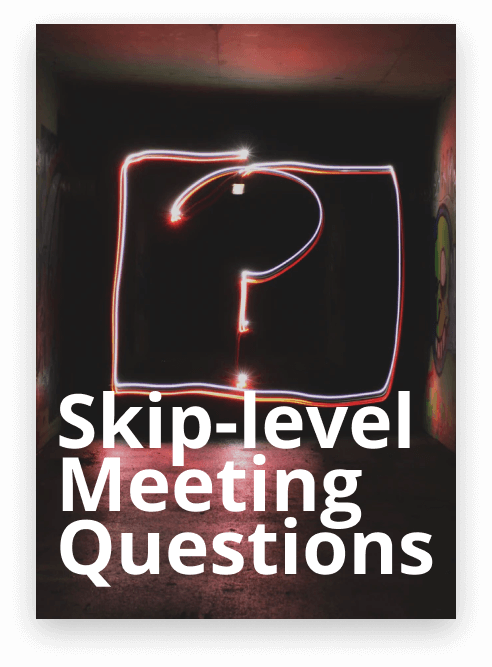Skip-level meetings are vital for big companies. But smaller businesses can profit from them as well. These meetings are the best way to solve serious problems in the most effective way. It is also one of the most stressful types of meetings due to multiple reasons such as the difficulty of communication and different vision of the problem from different levels of seniority within the company. Before organizing this kind of meeting, you need to go through some preparation steps and get a general idea of how to conduct them – and thanks to yoyomeeting, we bring you everything you need to know about skip-level meetings, including some tips about which questions to ask at a skip level meeting.
Skip level meetings: Winning strategy
Meetings in which there is a gap of one or more hierarchy levels between the bosses and managers and other staff are called skip-level meetings. The purpose of these meetings is to let managers know their team members better, build trust, and understand the employees’ problems.
From an employees’ perspective, it’s a great opportunity to talk with top managers and directors who run the organization for attendees from lower ranks within the company. These meetings present a unique opportunity to make a name for yourself, get noticed, and maybe get a promotion. This fact alone is enough to emphasize the importance of skip-level meetings. On the other hand, such sessions provoke more stress because attendees have to communicate with high-ranked professionals.
What’s in it for managers? Check out the article by Scott Boulton on LinkedIn. Here you can also follow our LinkedIn company profile to stay in the loop of the latest on meeting management excellence.
To get better results from a skip level meeting, do thorough preparations. Have a look at this to-do list:
Helpful Questions for Skip Level Meetings
Preparing for meetings can be helpful, and skip-level meetings with your boss or director are no different. However, there are some cases in which you cannot prepare properly for a skip level meeting. For example, you got a last-minute invitation, or you were too busy with an ongoing project. On the other hand, the stress might overwhelm you at any time and wreck your preparations. Luckily, there is always a shortcut. You will find some effective skip level meeting questions to ask your boss or a manager. For a manager, the skip level questions are a good tool to build trust with the employees and help the people in your team will feel more relaxed and open.
Over time you will build your patterns based on the skip level meeting questions. The habit will make skip-level meetings more effective and fruitful both for management and employees.
Download the skip level meeting questions here ⇒

Skip level meeting agenda
At yoyomeeting, we know the importance of writing a meeting agenda for a successful meeting. Skip-level meetings are not an exception to the rule. It would be hard to formulate a universal set of rules to follow when writing a skip level meeting agenda. You need to take into account numerous variables, including the difference in mindsets of executives and employees, the gap between their rank in the company, etc.
Firstly, be sure you get the purpose of the meeting right. Rarely executives and employees can talk with each other on par. A few correct questions would be enough to see whether your messages are perceived the way you expect, or there are some issues hidden from your eyes. The 1-on-1 format is the best for the job because it makes both sides feel comfortable.

Managers should ensure employees that their conversation will remain anonymous, and nothing will be used against them. This guarantee will ensure that the employees will be able to speak their mind. A less trustful approach may wreck the results of a skip level meeting. The management won’t be able to get real thoughts and comments from their staff.
Planning skip-level meetings in detail from the ice breaker to the conclusions will help you drastically improve their efficiency. Planning how you will answer the usual questions, how you will lead the conversation, which points you will discuss, and which you will leave out. Whatever you do, keep your focus on the specific areas that will assure the biggest positive impact on the company and your team. Even in cases when your team member talks too much, let them express themselves but keep them within the target topic.
If you have a problem putting together the items while writing meeting agendas, consider adding the following items to spark the conversation:
- So far, what was the most difficult topic to comprehend – is it related to the strategy or day-to-day goals?
- What goals have you accomplished in the past few years (months) and what you’re planning to achieve in the next 6 (12) months?
- What makes you happy at work in your current role? Would you like to improve something?
- Name one thing to start/stop doing (as an organization) and one thing we should continue doing?
Final advice
Skip-level meetings provide deep firm-related insights for the management of different levels. These meetings can be super time-consuming due to tons of information to analyze and organize. To make this process easier, consider giving yoyomeeting a try. It is a robust Office 365 meeting minutes add-in with flexible settings and a wide array of tools to work with before, during, and after all kinds of meetings. With yoyomeeting, top managers, directors, and team members in every department of the company on every level can easily plan, run, and follow up on meetings. Start using yoyomeeting for free now!
Get Your Free Trial of yoyomeeting
Want to try yoyomeeting out for yourself? Start using our office 365 meeting minutes software for free, with our 2-week trial. Yoyomeeting helps you manage all phases of your business meetings, including meeting planning, meeting recording, and meeting recaps.
Here are some of our amazing features:
- Agenda Management
- Meeting Attendee Management
- Notes & Minutes
- Task Assignment
- Decision Recording
- …and more!
We guarantee your business meetings will change for the better.







